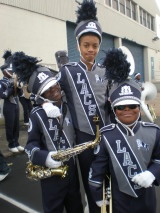-
Category 1
Selected in 2012
-
Grades: pre k - 8
School Setting: urban
Town Population: 360,740
Student Enrollment: 918
Student Demographics:
Black/African American: 98%
Teacher/Student Ratio: 1:11
White/Caucasian: 1%
Hispanic: 1%
Hawaiian/Pacific Islander: 0%
Asian: 0%
Native American: 0%
Other: 0%
% Reduced Lunch: 89%
% ELL Learners: 0%
Founded: 2006 -
PRINCIPAL:
Mickey Landry -
CONTACT:
2727 S. Carrollton Avenue
New Orleans, LA 70118
504-861-7957
Jeanne.Huber@choiceschoolsno.org
Lafayette Academy Charter School
New Orleans, LA
Because the schools follow practices that are grounded in research about teaching in urban schools, there are some predictable strands for the standards instructional personnel are expected to meet. Among those are:
1. Depth of understanding of state standards.
2. Facility with data management and analysis.
3. Facility with the Direct Instruction model, including knowledge and practice of differentiation of instruction in the mixed ability classroom.
4. Creating and implementing classroom and school-wide culture appropriate for urban students.
- Describe specific programs in place to ensure that families are involved in the success of your school and students.
-
Describe specific programs in place to ensure that families are involved in the success of your school and students.
Parent and school relations are an integral part of our school community. The school participates in community events such as parent recruitment fairs and advertises on local radio stations to share with families our vision for their students as it relates to their academic as well as social well beings. As with most schools, however, parent-to-parent word of mouth is our best marketing tool.
We participate in the RSD common application process and adhere to its guidelines. Prior to the opening of school, we conduct three parent and student orientations to orient them on the expectations of the school and the benefits of attending. We have a yearly Healthy Living Fair in October to provide our families and community with information and resources that will support a healthier lifestyle. There are academic nights throughout the year to keep parents abreast of and participating in curriculum activities, and opportunities to chaperone classroom field trips that extend learning.
Parents are invited to the monthly behavior celebrations and quarterly academic celebrations to praise students for making good choices. Through the volunteer program, parents can tutor, be reading buddies or room mothers. The end of year events (graduations for Pre-K, K and seventh grade) are the celebratory period where we all come to acknowledge each student’s accomplishments and give well wishes for the future. - What is the single most important factor in the success of your school that others could replicate?
-
We believe that site-based management is appropriate for our schools and that the school site management is done within the larger framework established by the organization.
We have come to describe that framework in a formula that is expressed as follows:
Total Instructional Alignment + Data-Driven Instruction + Extensive Student and Family Support =Choice Foundation School
The alignment part of that formula refers to our practice of aligning everything we do with state standards (and in the future to the Common Core State Standards). Main texts are aligned in great detail--to the point that every text is graded by a third party agent that scores every text, standard-by-standard, on how well or poorly aligned the text material is relative to the state requirement. Teachers and administrators reference that alignment to plan instruction and fill gaps that exist between what the text covers and what the standard requires. In a similar way, lesson planning and execution are aligned with both state standards and researched effective teaching practices.
Interim assessments are calendar-paced and aligned to standards as well. The tests are visual twins for the state tests. Responsive instructional plans are made based on the data generated by those assessments as well as similarly constructed daily and weekly assessments that are teacher-made. Data conversations are varied and routine.
Recognizing that post-Katrina New Orleans students and families of poverty need more than the usual planks of support found in urban schools, we provide a significant number of in-school services to support the families’ needs. We know, for example, that getting to the doctor is difficult for poor families who move frequently and do not have transportation available to them. So, we provide immunizations, eye care, and dental care in our buildings.
That framework will not change for any school Choice Foundation operates. It may differ by a tweak or two from one school to another, but we believe that those elements need to be in place in order for our students and teachers to be successful. - Describe the program or initiative that has had the greatest positive effect on student achievement.
-
The outreach to the families and students in our schools include partnerships with numerous organizations. At Lafayette Academy this program is overseen by our Assistant Head of School for School Culture. At Esperanza Charter School it is overseen by the Dean of Students. In that effort, both are supported by our nurse, our social workers; Lafayette also has one fulltime volunteer coordinator. Partner organizations include:
Junior League of Greater New Orleans
• Provides 4 volunteers (rotating out of a pool of 14 assigned to the current Choice Foundation school in New Orleans) who help in the first grade classrooms.
• Birthday Club for pre-k, k, 1st and 2nd grades monthly.
• 4 or 5 faculty luncheons
• Help staff the Holiday Superstore and donate
• Staffs and funds Field Trips (admission and transportation costs)
• Kids in the Kitchen
• Classroom stipends for supplies
• Fund Weekly Reader
• Organize and provide 25 volunteers to read and lead an art activity for “Read for the Record.”
• Organize and staff Read Across America - 2nd graders
Isidore Newman School
• At their annual Book Fair, Newman parents purchase books to donate to the current Choice Foundation school’s Reading Room.
• Newman STARS Program – In the spring Newman fourth-graders set up experiments for our fourth graders to participate in.
• Newman teachers are working with our students and Newman’s to produce a musical.
Big Brothers Big Sisters of Southeast Louisiana
• Offers a mentor to students in the school or out in the community. The purpose is to build positive relationships while having fun and exposing students to new experiences.
CADA Council on Alcohol and Drug Abuse
• Provides prevention education on alcohol and drug abuse through a 10 week research based curriculum with our 5th, 6th and 7th grade students.
• Help students identify the pressures that lead to substance abuse and provide students with resistance skills essential in resisting experimentation with alcohol or drugs.
Family Services of Greater New Orleans
Children’s Mental Health Center
• Provides individual and group counseling to our students who are coping with life stresses, including but not limited to, grief/ loss, anger, appropriate feeling expression, self esteem, conflict resolution, socializing, impulse control, and disaster related stressors.
CART (Child and Adolescent Response Team)
• Response team for support services during times when a child or adolescent is in crisis. CART services are available 24 hours a day, 7 days a week.
No Task Truancy Program of New Orleans
• Provides intensive truancy case management for at risk students with 5 or more unexcused absences.
• Incorporate family preservation with in home assessments assisting with barrier breakage to school attendance.
Healing Hearts For Community Development
• Offers Life Skills Training (LST). It is a research-validated substance abuse prevention program to reduce the risks of alcohol, tobacco, and drug abuse and increase the availability and effectiveness of general health promotion and education messages. A facilitator comes in to provide Life Skills Training for eight weeks with our 2nd and 3rd grade students.
Louisiana State University Health Sciences Center (LSUHSC)
• Provides mental health services in school and through their clinic to children and families who have experienced trauma.
• Provide consultation and training to faculty to be more aware of trauma and the importance of specialized trauma services to assist traumatized youth.
Seton Resource Center, Daughters of Charity Services of New Orleans
• Provides classroom-based interventions on issues such as trauma, violence, bullying, prevention, etc. Seton Resource Center also provides individual and group counseling and filial therapy for families.
• Provides the current Choice Foundation school in New Orleans with a Social Worker who is assigned to our school 4 days out the week.
Greater New Orleans Immunization Network
• Provides free immunizations to children that are not up to date with current immunization guidelines.
• Assess immunization status and history for entire school.
• Provides parents with current copy of shot records.
New Orleans Speech and Hearing
• Provides free vision, hearing, and speech screenings to students in grades pre-k, kindergarten and first.
• Provides parents with referral notices if any problems are found.
Xavier University Audiology Department
• Provides free hearing screenings to students in grades pre-k, kindergarten, first, third, and fifth in conjunction with New Orleans Speech and Hearing.
• Provides Xavier University students with needed clinical hours for graduation.
Reach Out Dental America
• Provides dental exams and provides treatment if needed.
Urban League of Greater New Orleans
• Provides support to parents through its parent resource center.
That support has translated into a very high student retention rate at Lafayette Academy of over 95% each school year. Families rarely leave, and the most frequent reason given for leaving is moving out of town. Lafayette has had waiting lists of 200-500 in 2008, 2009, 2010, and 2011. - Identify the professional development activities you use to improve the teaching portion of the teaching and learning process.
-
Because the schools follow practices that are grounded in research about teaching in urban schools, there are some predictable strands for the standards instructional personnel are expected to meet. Among those are:
1. Depth of understanding of state standards.
2. Facility with data management and analysis.
3. Facility with the Direct Instruction model, including knowledge and practice of differentiation of instruction in the mixed ability classroom.
4. Creating and implementing classroom and school-wide culture appropriate for urban students.
This process starts during initial interviews when potentially viable candidates may be asked to demonstrate their knowledge base of, say, data analysis. This is done by handing the candidate a spreadsheet that displays the performance of an actual group of students on a formal, interim assessment that is routinely used in the school. The candidate is given 60 seconds to assess the spreadsheet before being asked to provide a quick outline of the plan they might formulate to re-teach the standards covered in that assessment.
More formal training takes place prior to the opening of school when those broad outlines listed above are covered in more depth, first with new teachers, then with all teachers. Further training takes place based on observations of administrators and on teachers’ needs as expressed either in conversations, meetings, or surveys. For example, if teachers ask for more information on the use of technology for effective instructional practice or data management, a workshop will be held either on a professional day or in a routinely held meeting.
Whole school faculty meetings take place weekly, and there is always at least partial emphasis on professional development at those meetings. Meetings of divisions—groups of grade level teachers--are held weekly as well, and emphasis at those meetings is placed on the professional development needs of that specific group of teachers at that specific time. For example, a review of data management procedures might be held just before an interim assessment takes place. Finally, grade level teams meet once each week with their division head during their common planning time. At that time, teams “drill down” more deeply into specific needs. For example, they may share ideas on how to re-teach a specific skill or concept after getting the results of an interim assessment.
The Head of School is ultimately responsible for these tasks. This is done in consort with other academic administrators with whom the Head has weekly individual and group meetings. The professional needs of the faculty figure prominently in those meetings, and that is where the planning takes place.
Prior to the opening of the school, professional development will revolve around three major categories. First, new teachers will be introduced to school culture and to the school’s primary mode(s) of instruction; returning teachers will review and advance their knowledge in this category. Since TargetTeach has specific, definable ways of teaching, that methodology will form a significant portion of the weeklong training. Second, school wide and grade wide procedures and routines will be established and reviewed. Finally, a good portion of time will be spent on teachers “nesting” in their teaching areas—from classroom arrangements to bulletin boards. Throughout this time, meetings of different configurations will be held. Grade level teams will meet as will Divisions, and whole-school meetings will be held as well.
Teachers have time to meet each week in grade level teams with their frontline administrator to plan, to analyze data, and to problem solve. Grade level teams have the same planning periods.
Special education staff meets on their own with the Director of Special Education every week, just as regular education teachers meet with their Division Heads. The Director of Special Education and the Head of School work together on the planning of professional development needs of special educators. As described above, the Division Heads and the Head of School work on the plan for regular education teachers.
Of course, in an urban school full of “at risk” children, there is considerable overlap of the needs of these two groups of teachers. For example, classroom management is an area in which both groups of teachers require equal attention. This is especially true in a school that utilizes an inclusion model. So, the school spends a lot of time in before-school meetings and in weekly faculty meetings teaching and reinforcing the principles of best practice in that area.
One of the primary factors that drive school success, in our opinion, is getting all of the adults aligned with the mission, the curriculum, and the pedagogical schemes pursued by the school. For example, teachers who teach from the table of contents of a textbook are not aligned with the Louisiana Comprehensive Curriculum because it is likely that only 40-60% of state standards are adequately covered by any textbook adopted by the state. There are huge gaps in the knowledge required of students if the textbook is the only resource used by a teacher. So, teaching how to align instruction and instructional resources for mastery of state standards is an important topic in our professional development scheme.
In a similar way, we intentionally narrow our focus of professional development topics to those areas listed above in our Overview. When teachers display well-developed skills in those areas and intense interest in other areas, we will support them in any way we can within the limits of our resources.
There are five ways we evaluate the PD program. First, the patterns revealed by observations made by administrators as they make their rounds tells us the most important and timely information. For example, an administrator may notice that classroom management is slipping among a group of teachers because those teachers are failing to expect full compliance with their instructions before moving on to another task. If that occurs, those teachers will be asked to attend a review session on 100% compliance. (We use Harry Wong’s work for this.)
Second, interim assessments provide valuable information to us. If, for example, a teacher’s classroom profile on an interim assessment exhibits a deficiency in teaching a particular skills/skills, then the teaching of that skill will be addressed one-on-one with their Division Head or in a weekly grade level meeting or in a weekly Division meeting. If the skill/concept deficiency is widespread—for example, the teaching of higher order thinking skills—all-school faculty meetings, division meetings, and grade level meetings will address that need over a period of time.
Third, we may get feedback from outside observers. For example, if we have an ENI coach observe that the standard board configuration is not being adhered to by some teachers, we will reinforce that need as appropriate.
Fourth, of course, is the result of state tests. While the results of interim assessments are clearly predictive of LEAP/iLEAP results, we do, however, glean some additional information from state tests. For example, we track the value-added performance of teachers on those tests.
Finally, teacher feedback is an essential part of our evaluation. We view continuous professional development as an ongoing conversation that raises the level of performance of both teachers and administrators. That dialogical process tells us not only how we are doing, but where we need to go next with our professional development program. - Describe how data is used to improve student achievement and inform decision making.
-
Type of data dialogue
Whole-school conversations goal setting
Data used
LEAP/iLEAP
Who is involved
Entire staff
Conversation topics
Patterns of student achievement.
Needs for school-wide programs (instructional, curricular, professional learning).
Needs for additional knowledge and skills for staff. Start of year
Frequency
Mid year
End of year
--------------------------------------------
Type of data dialogue
One-on-one conversations with focus on multi-year growth of students
Data used
State assessments, and benchmark exams
Who is involved
Teacher and administrator
Conversation topics
Growth of students.
Overall proficiency of students.
Instructional strategies to meet student learning needs.
Frequency
With each assessment
---------------------------------------
Type of data dialogue
Grade-level teams with focus on individual student interventions
Data used
Student performance on classroom and common assessments, discipline records, and student work
Who is involved
Grade-level teams
Conversation topics
Diagnosis of individual knowledge and skills.
Next steps for students.
Grouping of students for instruction and intervention.
Pyramid of interventions.
Frequency
Once a month or as necessary
Stats
-
Category 1
Selected in 2012
-
Grades: pre k - 8
School Setting: urban
Town Population: 360,740
Student Enrollment: 918
Student Demographics:
Black/African American: 98%
Teacher/Student Ratio: 1:11
White/Caucasian: 1%
Hispanic: 1%
Hawaiian/Pacific Islander: 0%
Asian: 0%
Native American: 0%
Other: 0%
% Reduced Lunch: 89%
% ELL Learners: 0%
Founded: 2006 -
PRINCIPAL:
Mickey Landry -
CONTACT:
2727 S. Carrollton Avenue
New Orleans, LA 70118
504-861-7957
Jeanne.Huber@choiceschoolsno.org








